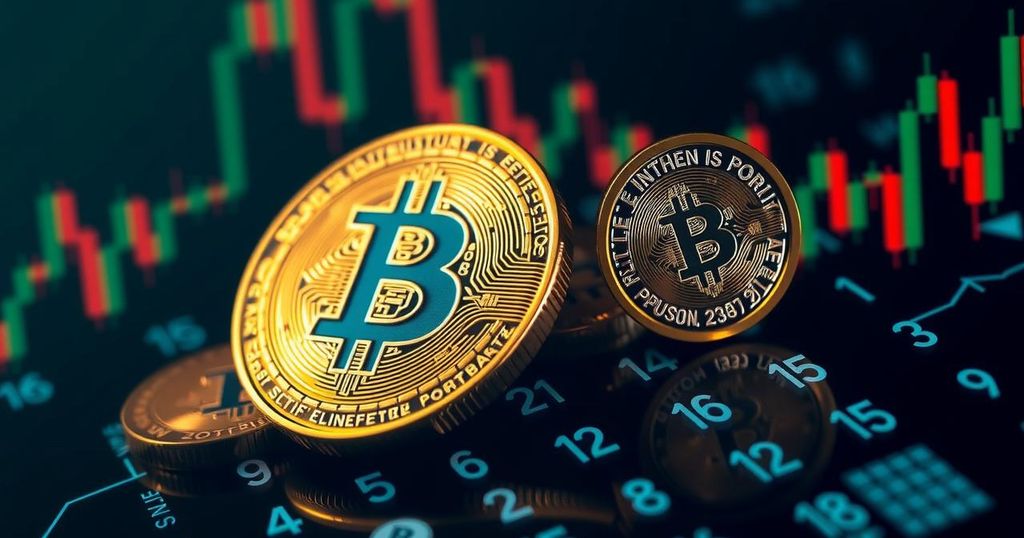Bitcoin Price Surge Approaches $70,000: Is a Bull Market Resurging?
Bitcoin has surged over 8% in the last week, reaching nearly $70K, primarily driven by strong demand from spot ETFs and whale accumulation. Despite the price increase, trading volume has decreased significantly, raising questions about market momentum. Historical performance patterns related to halving years add context to the current situation, suggesting potential for sustained upward movement, but caution is warranted due to trading volume dynamics and external economic factors.
Bitcoin has experienced a notable increase of over 8% this past week, reaching a high of $68,955 on October 19, although it has seen a significant decline in trading volume by 60% within the last 24 hours. The apparent demand for Bitcoin has surged, particularly following net purchases of approximately 8,000 BTC by spot exchange-traded funds (ETFs) in the United States, a major catalyst for the recent price rise. Whales, or large holders of Bitcoin, have further bolstered their positions, with their collective holdings surpassing 670,000 BTC. This recent bullish momentum has sparked renewed speculation regarding a potential new bull run within the cryptocurrency market. Bitcoin’s price rose from roughly $63,000 on October 13 to $68,955 on October 19, and it has since settled at $68,241. However, this upward movement is accompanied by distinct shifts in trading dynamics and demand metrics, painting a complex picture of market momentum. The recent appreciation in Bitcoin’s price aligns with a sharp decline in daily trading volume, which has fallen to approximately $14.71 billion—a decline of 60%. This discrepancy raises concerns regarding the durability of the price surge and may indicate a phase of profit-taking or market consolidation. Nonetheless, signals of institutional activity and a broader demand surge could be establishing a foundation for more sustained gains. According to the insights provided by CryptoQuant, an on-chain analytics firm, the notion of “apparent demand” is significant in fostering sustainable Bitcoin price rallies. Their data reveals a substantial recovery in Bitcoin demand after previous stagnation, with last week’s demand rising by 177,000 BTC—the most notable monthly increase since late April. This uptick in demand coincided with Bitcoin’s ascendance above the $67,000 mark, achieving a ten-week peak. The surge in spot ETF purchases has played a critical role in this demand growth. Having recorded nearly 8,000 BTC in net purchases on recent days—the highest figure since July—spot ETFs have emerged as a vital source of liquidity for the market. This behavior follows a similar pattern witnessed earlier in 2024, where daily spot ETF purchases averaged around 9,000 BTC, aiding Bitcoin’s rise to elevated price points. Moreover, whale activity remains a key factor driving the current price movements. Data from CryptoQuant shows that large holders outside exchanges and mining pools have increased their holdings to 670,000 BTC, exceeding the 365-day moving average. This accumulation trend indicates a strategic positioning by significant market participants, reminiscent of behaviors observed during previous bull runs. The timing of Bitcoin’s comeback is particularly noteworthy, aligning with the historical trend of positive performance in the fourth quarter of halving years. Historical data from 2012, 2016, and 2020 indicates price increases of 9%, 59%, and 171%, respectively, during these periods. Given that 2024 marks another halving year, recent developments are drawing parallels to the upward momentum seen in 2020 when Bitcoin’s price began a substantial rally. The actions of large holders also align with previous market dynamics, echoing the post-COVID recovery strategies witnessed in 2020. Analyst Woominkyu, a credible contributor on CryptoQuant, remarked, “Whales are ready to welcome ‘FOMO’ by dumb money,” suggesting that these significant players anticipate a new influx of retail investor enthusiasm. While the ongoing price rally invites optimism, the drastic decline in trading volumes invites scrutiny concerning the durability of the movement. The reduction in liquidity may signal a potential cooling-off period as traders engage in profit-taking after the recent surge. Nevertheless, the convergence of rising demand, institutional inflows, and favorable seasonal dynamics suggests that any forthcoming corrections may be short-lived. Challenges remain, however, with broader factors such as macroeconomic conditions, regulatory developments, and geopolitical events likely to influence market sentiments and liquidity. The entire cryptocurrency market continues to be responsive to fluctuations in investor outlook, particularly amidst increasing interest rates and global economic uncertainties. In conclusion, Bitcoin’s recent pricing advancements, bolstered by heightened demand and institutional participation, have ignited speculation of a new bull market. However, the interplay of trading volume dynamics and the active role of large market participants necessitate a cautious approach to potential market volatility. As the cryptocurrency landscape evolves, the next few weeks will be pivotal in revealing whether this upward movement is sustainable, positioning Bitcoin for a new era of high valuations or whether it constitutes a fleeting surge.
The article explores the substantial rise in Bitcoin’s price, which has climbed to nearly $70,000 following a period of apparent increased demand, particularly from institutional investors and large holders. It discusses the implications of decreased trading volumes, the significance of ETF purchases, and the potential for a renewed bull run in the context of historical performance patterns associated with Bitcoin’s halving years. It also examines the behaviors of market whales and assesses the broader economic landscape impacting Bitcoin’s future movements.
In summary, Bitcoin’s recent surge in price is indeed promising and linked to substantial demand from both institutional investors and large market participants. However, traders should remain vigilant due to the notable decline in trading volumes, which could indicate a potential short-term consolidation phase. As the cryptocurrency market continues to unfold, the next phases of this rally will be crucial in determining if Bitcoin is on the brink of a significant uptrend or facing a transient peak.
Original Source: alexablockchain.com








Post Comment